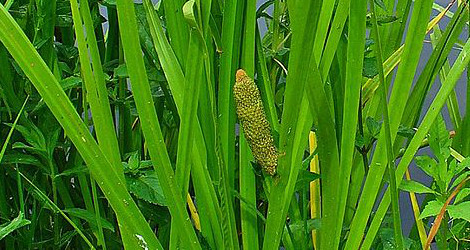Accession Data:
Acorus calamus L.
- Common Name: Sweet Flag
- Family: Acoraceae J.G. Agardh
- Description: Hardy perennial herb of marshy places, to 6 feet tall, aromatic, rhizome stout. The genus Acorus is considered to be the most primitive extant monocot.
Rhizome stout, 4-10(-20) x (0.8-)1-1.5(-3) cm, aromatic; roots at lower side of rhizome. Leaves several, mid-green, often reddish at base, ensiform, (60-)70-100(-150) x (0.7-)1-2(-2.5) cm (mostly 1-1.5 cm wide), apex acuminate; midrib conspicuous on both sides. Peduncle compressed triangular, (15-)40-50 cm. Spathe mid-green, leaflike, 30-50 cm, acute. Spadix straight or slightly curved, erect, oblique, narrowly conic to subcylindric (tapering toward apex), 4.5-6.5(-8) × 0.6-1.2(-1.5) cm, densely flowered. Flowers yellowish green, 1.8-2 mm in diam. seen from above; tepals oblong, 2.5-3 × 1-1.2(-1.4) mm, keeled, membranous, apex triangular hooded; filaments oblong, flat, 2-2.5 x 0.3-0.5 mm, anthers cream-colored, 0.4-0.5 mm in diam.; pollen grains ca. 20 µm, exine shallowly and remotely foveolate; gynoecium obconic-cylindric, 2.5-3.5(-4) × (0.8-)1-2.3 mm, with conic, spongy apex and stigma very small. Infructescence 1.5-2 cm in diam., straw-brown at maturity, berries densely arranged. Berry oblong-obovoid, 1- to few seeded, (3.5-)4-4.5 × 2-3(-3.5) mm. Seed oblong-ellipsoid to ovoid, 2.5-3(-4) × 1-1.2(-1.8) mm, without bristles; testa light brown, subsmooth and slightly foveolate. Fl. (Feb-)Apr-Sep. 9
- Uses:
Plant pacifies vitiated vata, kapha, insomnia, insanity, other mental diseases, epilepsy, mania, stomatitis, hoarseness of voice, colic, flatulence, amenorrhea, dysmenorrhea, neuropathy, renal calculi, cough, inflammation, arthritis, kidney diseases, hemorrhoids, skin diseases and general debility.3
Useful part: Underground rhizomes.
In Ayurveda, Sweet Flag is also known as VACHA. This translates from Sanskrit as "speech." This plant is more traditionally used as a brain tonic which also improves speech ability. It is used to reduce Kapha and Vatha while increasing Pitta. Calamus root has been used in various respiratory ailments. Making a decoction of the leaves and drinking it, will ease dry coughing, asthma, bronchitis, and fever. It is known as a bronchodilator, therefore circulates more oxygen to the brain & reduces toxins from the brain. An infusion treats cholic. Acorus Calamus is known as a sedative, used in mixtures to aid in mental hysterics: epilepsy, anxiety, over-stimulation.
Massaging Calamus oil around the lymph nodes will stimulate drainage. Treats arthritis, sinus headaches, increases endurance and improves muscle tissue.
- IMPORTANT NOTE: Plant Uses are for informational purposes only. EEB Greenhouses assume no responsibility for adverse effects from the use of any plants referred to on this site. Always seek advice from a professional before using any plant medicinally.
- USDA Zone: 3-10
Accession Data:
- Accession # 199700056
- Source: Don Les
- Accession Date: 08-05-1997
- Bench: 2316 - Equisetum
- Currently: active - healthy
- Qty: 2 confirmed on 04-24-2025
- Restrictions:
Classification:
- Division: Magnoliophyta
- Class: Liliopsida
- SubClass: monocots
- Order: Acorales
- SubOrder:
- Family: Acoraceae
- SubFamily:
- Tribe:
- SubTribe:
Flowering Data:
This accession has been observed in bloom on:| Year | Jan | Feb | Mar | Apr | May | Jun | Jul | Aug | Sep | Oct | Nov | Dec | ||||||||||||||||||||||||||||||||||||||||
|---|---|---|---|---|---|---|---|---|---|---|---|---|---|---|---|---|---|---|---|---|---|---|---|---|---|---|---|---|---|---|---|---|---|---|---|---|---|---|---|---|---|---|---|---|---|---|---|---|---|---|---|---|
| 2025 | ||||||||||||||||||||||||||||||||||||||||||||||||||||
| 2024 | ||||||||||||||||||||||||||||||||||||||||||||||||||||
| 2023 | ||||||||||||||||||||||||||||||||||||||||||||||||||||
| 2022 | ||||||||||||||||||||||||||||||||||||||||||||||||||||
| 2021 | ||||||||||||||||||||||||||||||||||||||||||||||||||||
| 2020 | ||||||||||||||||||||||||||||||||||||||||||||||||||||
| 2019 | ||||||||||||||||||||||||||||||||||||||||||||||||||||
| 2018 | ||||||||||||||||||||||||||||||||||||||||||||||||||||
| 2017 | ||||||||||||||||||||||||||||||||||||||||||||||||||||
| 2016 | ||||||||||||||||||||||||||||||||||||||||||||||||||||
| 2015 | ||||||||||||||||||||||||||||||||||||||||||||||||||||
| 2014 | ||||||||||||||||||||||||||||||||||||||||||||||||||||
| 2013 | ||||||||||||||||||||||||||||||||||||||||||||||||||||
References (internal):
- Medicinal Plants
- Aquatic Plants
- Medicinal Plants - Ayurveda Medicine
- EEB 3271 - Systematic Botany
- Medicinal Plants - Nervous System
- Medicinal Plants - Circulatory System
- Medicinal Plants - Respiratory System
- Medicinal Plants - Musculoskeletal System
- Medicinal Plants - Traditional Chinese Medicine
- EEB Greenhouse Holdings native to: Altay / Buryatiya / Chita / Irkutsk / Krasnoyarsk / Tuva / West Siberia / Yakutskiya / Amur / Khabarovsk / Kuril Is. / Primorye / Sakhalin / Kazakhstan / Kirgizistan / Uzbekistan / China South-Central / Hainan / Inner Mongolia / Manchuria / China North-Central / Qinghai / China Southeast / Tibet / Xinjiang / Mongolia / Japan / Korea / Assam / Bangladesh / East Himalaya / India / Laccadive Is. / Maldives / Nepal / Sri Lanka / West Himalaya / Cambodia / Myanmar / Thailand / Vietnam / Borneo / Jawa / Lesser Sunda Is. / Malaya / Philippines / Sulawesi / Alaska / Northwest Territories / Alberta / British Columbia / Manitoba / Saskatchewan / New Brunswick / Newfoundland / Nova Scotia / Ontario / Prince Edward I. / Québec / Idaho / Montana / Washington / Illinois / Iowa / Kansas / Minnesota / North Dakota / Nebraska / South Dakota / Wisconsin / Connecticut / Indiana / Maine / Masachusettes / Michigan / New Hampshire / New Jersey / New York / Ohio / Pennsylvania / Rhode I. / Vermont / Virginia / District of Columbia
References (external):
- Plants For A Future Website
- Hortus Third, LH Bailey Hortorium, 1976
- Ayurvedic Medicinal Plants - website no longer on line 19JUL2012
- The Plant List (2013). Version 1.1. Accessed 27 March 2105.
- WCSP (2015). World Checklist of Selected Plant Families. Facilitated by the Royal Botanic Gardens, Kew. Accessed 27 March 2015.
- Acorus calamus at Wikipedia. Last accessed on Thursday, October 26, 2017.
- Image #00 (cropped) & #01 (original) by H. Zell (Own work) [GFDL or CC BY-SA 3.0], via Wikimedia Commons. Last accessed on Thursday, October 26, 2017.
- Deepak Chandra Phytochemicals of Acorus Calamus (Sweet flag). Journal of Medicinal Plants Studies 2017, 5(5); 277-281. Last accessed on Thursday, March 29, 2018.
- Flora of China. Last accessed on Monday, 29 April, 2019.
- Angiosperm Phylogeny Website at MoBot. Last accessed on Tuesday, 03 December, 2019.
data regenerated on Thu, 24 Apr 2025 08:27:01 -0400 [bcm v4.0]
Images:

Additional images for this accession:
Click on thumbnails to enlargeCurrent Accessions in the Acoraceae
W/C = Wild Collected = indicates flowering in past 14 days
= indicates flowering in past 14 days
 = images available for this accession
= images available for this accession
 = map available for this accession
= map available for this accession
 = accession added within past 90 days
= accession added within past 90 days


